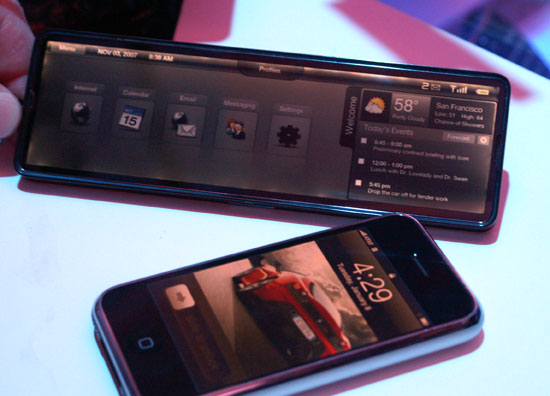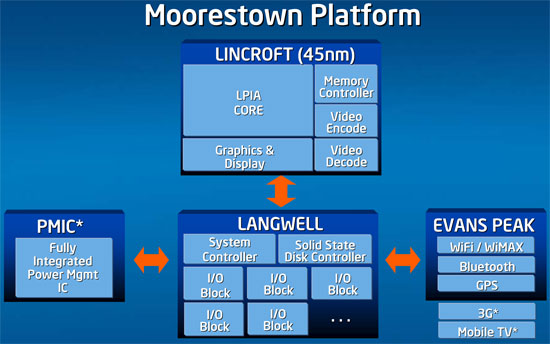Intel's Atom Architecture: The Journey Begins
by Anand Lal Shimpi on April 2, 2008 12:05 AM EST- Posted in
- CPUs
Final Words
Over the next six months we will begin seeing the first devices based on Intel's Atom processor. For 2008, Intel expects to see Atom used primarily in 5" form factor MIDs (Mobile Internet Devices). I've played with prototypes of these Atom based MIDs and honestly, they are not any more impressive than the UMPCs that preceded them. The interfaces are sluggish, the devices are still too bulky and I'm not completely convinced that they're worth the added hassle of carrying one around with me all day.
Intel seems to think that Atom based portable GPS devices will be some of the more interesting devices out this year, and while I see some potential there I'm just not that excited.
It's a shame because I am quite excited about the Atom processor, or its future to be more specific. I'm honestly fed up with poor performance in just about every consumer electronics device that I live with - I want the sort of responsiveness that I get with my desktop or notebook, but I want that in my cable box, in my TVs, mobile phones, Blu-ray players, toasters, etc...
The first iteration of Atom simply won't deliver on enough fronts to make the sort of revolutionary changes I want. It lacks the level of integration necessary for truly portable devices and where I really want to see it isn't in bulky MIDs and UMPCs, but rather in things like the iPhone.

The iPhone (bottom) and a mockup of what the Atom could be in within 3 years (top)
I don't have high expectations for Atom today, while it will surely enable even more EeePC-like devices it's the processor's future that I'm most interested in - and Intel is too. You can find Intel silicon in the majority of desktop and notebook PCs shipped, but if Intel were able to make Atom a success you would find Intel in much, much more. TVs, phones, set top boxes, MIDs, all of these would be running x86 and potentially Intel processors. We always wondered what Intel would do to its spare fab capacity if it integrated a north bridge/memory controller onto its CPUs, with Atom we now have that answer.
The beauty of Atom being successful in these markets is that it doesn't just benefit Intel but AMD and the markets as a whole. Intel will be in for a fight once it begins competing with ARM based processors for space in the CE market, which should promote competition. In those areas where Intel does manage to bring x86 where it hasn't been before, those will quickly become areas where AMD can offer an Atom alternative. Remember that AMD built much of its CPU business on offering a more cost effective x86 alternative to Intel; there's no reason to believe that the same trend won't continue should Atom become successful in the CE industry.
Competition is a very good thing and it's rare that Intel plays the underdog in an industry, but with Atom it most definitely is. The road ahead will be a long one for Intel and its new baby, but the future does look very bright:

What made Atom possible is also what will make it better over time. Moore's law should mean some very interesting things are in store for the processor. The Moorestown update will bring about a more integrated solution, finally enabling Atom to find its way into larger smart phones.

Moorestown will bring an integrated memory controller to Atom among other things...
Take things one step further with an eventual 32nm shrink of Moorestown in the 2011/2012 timeframe and I think we may just be able to have x86 everywhere at the start of the next decade.










46 Comments
View All Comments
highlandsun - Thursday, April 3, 2008 - link
With all due respect to Fred Weber, with Atom at 47 million transistors, it's pretty obvious that the 10% figure for X86 ISA compatibility is not negligible, particularly in this performance-at-absolute-minimum-power space. Anybody using X86 in tiny embedded systems is automatically giving up a chunk of their power budget that someone using a cleaner instruction set encoding can apply directly to useful work. And as the previous poster already pointed out - source code portability is the only thing that matters to application developers, and that's a non-problem these days. Using the X86 instruction set encoding is stupid. Using it on a low-power-budget device is suicide.Jovec - Thursday, April 3, 2008 - link
I don't think the 10% reference meant 10% of all chips, but rather 10% of the current chip at the time the statement was made. In other words, x86 instruction decoding requires (roughly) a fixed amount of transistors for any chip, so the smaller the die size and larger the transistor count, less and less space is devoted to it.highlandsun - Thursday, April 3, 2008 - link
Yes, that's obvious. And it's also obvious that Atom at 47 million transistors is paying a greater proportionate cost than Core2 Duo at 410 million transistors. In 2002 when Fred made that statement, AMD's current chip was the AthlonXP Thoroughbred, with about 37 million transistors. At the same time the Pentium 4 had 55 million. Put in context, I'd guess that the Atom at 47M vs P4 at 55M has more than 10% of its resources devoted to X86 decoding.Also, Fred's statement in 2002 didn't take into account the additional complexity introduced by the AMD64 instruction extensions, where now a single instruction may be anywhere from 1 to 16 bytes long. Given that you're doing a completely clean ground-up chip design in the first place, it would have made more sense (from both a power budget and real estate perspective) to design a clean, orthogonal, uniform-length encoding at the same time.
Cross-platform ABI compatibility is stupid in the context they're aiming for; nobody is going to run their PC version of Crysis or MSWord on their cellphone. All that matters is API compatibility. With a consistent API, you can still run a separate binary translator if you really really want to move a desktop app to your mobile device but in most cases it would be a bad idea because a desktop app is unlikely to take advantage of power-saving APIs that would be important on a mobile. I.e., most of the time you're going to want purpose-built mobile apps anyway.
floxem - Tuesday, April 15, 2008 - link
I agree. But it's Intel. What do you expect?maree - Thursday, April 3, 2008 - link
I dont think MS will be ready before Windows 7 is released, which is another 3-5 years... and might coincide with Moorestown. Microsoft started work on WindowsLite only after releasing Vista. Vista is bloatware as of now. As of now MS has to rely on crippled versions of XP and Vista like starter and home, which is not very ideal.Apple and Linux are going to have a free run till then...
TA152H - Wednesday, April 2, 2008 - link
Bringing up the Pentium is a little strange, because the whole market is completely different.The Pentium wasn't supposed to be for everyone when it came out. The processor market was different back then where previous generations lasted a long, long time. The Pentium wasn't supposed to replace the 486 right away, or even quickly, and being huge and a terrible power hog was acceptable because the initial iteration was just for a very small group of people who absolutely needed it. The original Pentium had a lot of problems, and struggled badly to reach 66 MHz, so they sold most of their processors at 60 MHz. The second generation was intended more for mainstream.
Nowadays the latest generation replaces the earlier much more quickly, and has to cover more market segments more quickly. I still remember IBM releasing new machines for the 8086 in 1987. That's 9 years after the chip was made. It's just a different market.
The Pentium is nothing like the Silverthorne though, and it's a strange comparison. The Pentium executed x86 instructions, it wasn't decoupled. It also had both pipes, the U and V, lockstepped, which is limitation the Silverthorne doesn't have.
Saying the Pentium Pro was the first processor that allowed out of order processing is strange indeed. The only other processor this would have made sense with was the Pentium, since it was the only previous processor that was superscalar. So, they only made one in order processor, and then went to out of order with the next. It's difficult to see the extrapolation from this that it will be five years or more before Silverthorne goes out of order. It might be that long, but the backwards reference shouldn't be used to back that; it does more to contradict it.
Anand Lal Shimpi - Wednesday, April 2, 2008 - link
The Pentium reference was merely to show that what was once a huge, 300mm^2 design could now be built on a much, much smaller scale. And starting from scratch it's now possible to build something in-order that's significantly faster.The Pentium was an obvious comparison given that it was Intel's last two-issue in-order design, but I didn't mean to imply anything beyond that.
It won't be too long before we'll be able to have something the speed of a Core 2 in a similarly small/cool running package as well :)
Take care,
Anand
fitten - Wednesday, April 2, 2008 - link
I remember back in the days of the Mac FX we talked about 'what ifs' like making a 6502 with the (then) modern process technologies and how fast would it run. I wonder what about now :)crimson117 - Wednesday, April 2, 2008 - link
I am SO going to hold you to that! But I can only hope "won't be long" will mean within 12 months rather than within 12 years :P
Especially after my fiasco mounting a Freezer 7 Pro on an Abit IP35-E, I'd love if a heatsink weren't even necessary.
Anand Lal Shimpi - Wednesday, April 2, 2008 - link
12 months won't be a reality unfortunately :) But look at it this way, the first Pentium M came out in 2003? And 5 years later we're able to have somewhat comparable performance with the Atom processor.I'm really curious to see what happens with Atom on 32nm...